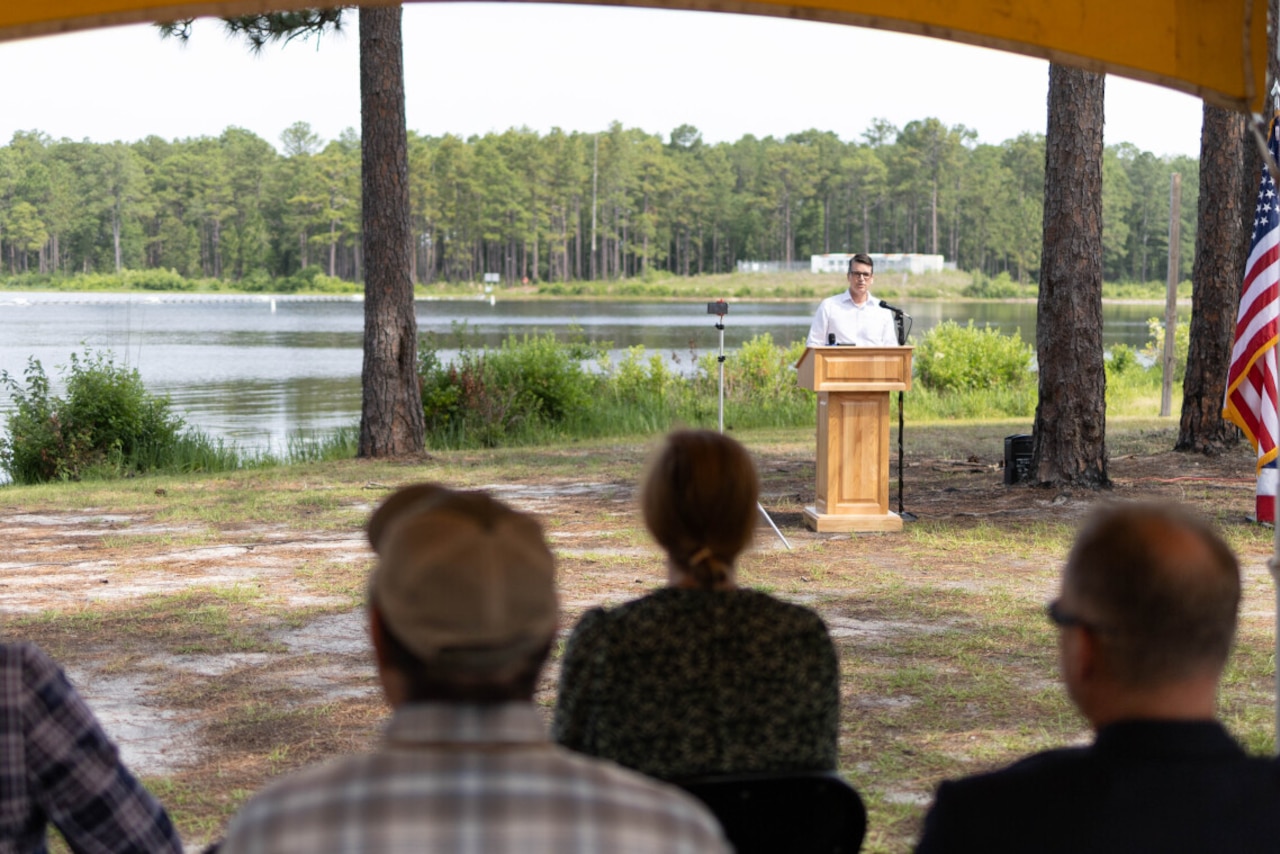Officials announced an agreement today between the Defense Department and an East Coast-based utility company to provide carbon pollution-free energy to installations throughout North and South Carolina.
Under a first-of-its-kind contract, unveiled today during a ceremony at Fort Liberty, North Carolina, Duke Energy Progress LLC will supply five of the region’s largest military installations with 4.8-million-megawatt hours of carbon pollution-free electricity through 2041.
The estimated $248 million contract represents a significant step toward achieving net-zero emissions across government operations and sends a strong demand signal to clean energy producers, officials say.
“This is a significant step forward,” said Brendan Owens, assistant secretary of defense for energy, installations and environment and DOD’s chief sustainability officer. “By supporting the construction of new clean, renewable energy, we are enhancing our resilience in support of the warfighter and DOD’s mission.”
The contract aligns with President Joe Biden’s December 2021 executive order directing federal agencies to lead by example in transitioning to clean energy solutions as part of the United States’ broader goal to reach net-zero emissions by 2050.
The order directs each federal agency to increase use of carbon pollution-free electricity as a share of total electrical energy use.
It sets a goal of reaching 100% carbon-free electricity on a net annual basis and matching 50% of the federal government’s electricity consumption with clean sources on a 24-hour basis by fiscal year 2030.
During today’s ceremony, Andrew Mayock, who leads White House climate efforts as the federal chief sustainability officer, underscored the imperative to take action.
“We live in a time of records: record heat, record drought, record floods,” Mayock said. “And we need to be resilient to all of those records.”
He added that, while climate change poses a critical risk, “we also live in a time of extraordinary economic opportunity, which today’s announcement also represents.”
Mayock said clean energy investments are expected to top $2 trillion this year for the first time in history. The U.S., he said, continues to lead in the clean energy transition.
Carbon pollution-free electricity encompasses a wide variety of technologies including wind, solar, nuclear and hydroelectric energy, among others.
The net-zero goals are measured through purchased, on-site and grid-supplied carbon pollution-free electricity in addition to purchased energy attributable certificates.
Energy attributable certificates certify that an entity has purchased renewable energy that has been produced and added to the grid separate from the agency’s purchase of physical power.
“When President Biden put the challenge out there for carbon-free electricity production for the federal government, we knew DOD would be ground zero for a lot of this,” Owens said. “DOD is the largest consumer of energy in the federal government and one of the largest consumers of energy in the world. So, we knew that we had to step up.”
As part of the agreement with Duke Energy Progress LLC, DOD has contracted two solar projects that will provide an estimated 330-gigawatt hours of carbon pollution-free energy in its first year of operation. Both projects are expected to be operational in 2027.
The solar projects will provide enough energy to meet 75% of DOD’s carbon pollution-free energy target within Duke Energy Progress LLC’s territory.
The installations receiving power from the project include Fort Liberty, Camp Lejeune, Marine Corps Air Station Cherry Point and Seymour Johnson Air Force Base in North Carolina, and Shaw Air Force Base in South Carolina.
Defense officials say achieving the milestones laid out in the executive order requires new ways of doing business. With the newly announced agreement DOD is leading the way in the whole-of-government effort to power federal facilities using clean energy technology.
The DOD’s agreement with Duke Energy is the first to aggregate military installations within a particular service area to tap into a large available load of carbon pollution-free electricity, in this case supplied by solar arrays, both located in South Carolina.
Previous clean electricity purchase agreements, normally completed by individual services or installations, have matched installations to generating facilities on a one-to-one basis.
By aggregating the installations into one agreement, DOD is able to tap into a larger pool of available clean electricity and make larger strides toward hitting the department’s clean energy goals.
“That’s just a quick example of the forward thinking that our teams have to do in order to accomplish the goals set forth by the administration,” Charlene Woods, a contracting officer with Defense Logistics Agency, said.
DLA has a 70-plus-year history of matching DOD and other government entities with comprehensive energy solutions. Officials say that expertise is critical for making large strides toward reaching the department’s clean energy goals.
The agency has, for years, had a pathfinder program in place to scout new sources of clean energy offered by utilities and it has helped DOD components tap into those sources.
DLA has also stood up a new program office to further ensure DOD and partner agencies meet the goals outlined in the executive order.
Air Force Col. Jennifer Neris, DLA’s director of carbon pollution-free energy, said the institutional knowledge gained from getting the Duke Energy contract in place will be instrumental for making additional progress.
“There are a lot of lessons learned that we will take forward into our other procurements as we go forward,” Neris said.
Susan Call, DOD’s director of installation clean energy and energy efficiency, emphasized that teamwork across the interagency and with partners in the private sector is key to meeting clean energy goals.
“It is a collaborative effort, and we couldn’t do this without the partnerships,” she said.




















Discussion about this post